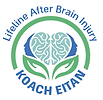Understanding Stroke
& Brain Injury
WHAT IS A STROKE?
A stroke is a serious medical event caused when blood flow to the brain is suddenly interrupted or reduced. This prevents the brain from getting the oxygen and nutrients it needs, causing brain cells to start dying within minutes. Stroke is the second-leading cause of death worldwide and a leading cause of disability.
TYPES OF STROKE
There are two main types of strokes:
Ischemic stroke- This is the most common type of stroke. It happens when a blood clot blocks the flow of blood to the brain. An ischemic stroke is much like a clogged pipe; blood can’t get through to the brain, so parts of the brain don’t get the oxygen they need.
Hemorrhagic stroke- This happens when a blood vessel in the brain bursts, causing bleeding inside the brain. The bleeding puts pressure on the brain and reduces the flow of oxygen-rich blood to brain tissue.
SIGNS OF A STROKE
When it comes to a stroke, time is critical. The faster you recognize the signs and get medical help, the better the chances of survival and recovery.
A simple way to remember the most common signs of stroke is with the acronym FAST.:
-
Face drooping: One side of the face may droop or feel numb. Ask the person to smile—does it look uneven?
-
Arm weakness: One arm may be weak or numb. Ask the person to raise both arms—does one drift downward?
-
Speech difficulty: Speech may be slurred or hard to understand. Can the person repeat a simple sentence clearly?
-
Time to call emergency services: If you notice any of these signs, even briefly, call emergency services immediately.
Other symptoms can include sudden numbness (especially on one side of the body), confusion, trouble seeing, dizziness, or a severe headache with no known cause.
Even if the symptoms go away, it may still bel an emergency. Quick action can save a life and reduce the risk of long-term effects.
EFFECTS OF A STROKE
The brain is an incredibly complex organ, responsible for controlling everything we do—from breathing and speaking to thinking, feeling, and moving. It’s made up of different areas, each in charge of specific functions. When a stroke happens, blood flow to a part of the brain is blocked or reduced, which means that area doesn’t get the oxygen and nutrients it needs. Without quick treatment, brain cells begin to die, and the functions controlled by that area of the brain are often affected.
The effects of a stroke depend on:
-
The location of the blockage or bleeding
-
The size of the area affected
Strokes can have different effects depending on where in the brain they occur:
Frontal lobe (front of the brain):
-
Controls movement, problem-solving, emotions, behavior, and speech.
-
A stroke here can cause weakness or paralysis (often on one side of the body), changes in behavior, difficulty speaking (aphasia), or trouble with thinking and planning.
Parietal lobe (top and back of the brain):
-
Processes sensory information like touch, temperature, and pain.
-
A stroke in the parietal lobe can lead to trouble with spatial awareness, difficulty understanding where parts of your body are, or problems with reading, writing, and math.
Temporal lobe (sides of the brain):
-
Handles memory, understanding language, and hearing.
-
A temporal lobe stroke can cause memory loss, trouble understanding spoken words, and issues with hearing or recognizing sounds.
Occipital lobe (back of the brain):
-
Controls vision.
-
A stroke in this region often leads to visual problems, such as partial or complete loss of vision in one or both eyes or trouble recognizing objects.
Cerebellum (bottom of the brain):
-
Coordinates balance and movement.
-
A stroke in the cerebellum can cause dizziness, balance issues, uncoordinated movement, or difficulty walking.
Brainstem (connects the brain to the spinal cord):
-
Controls basic life functions like breathing, heartbeat, and consciousness.
-
A brainstem stroke can be especially serious, leading to problems with breathing, heart rate, swallowing, speech, and even paralysis on both sides of the body.
No two strokes are exactly the same. Some people may experience mild symptoms, while others have severe, life-changing effects. That’s why every stroke is a medical emergency—getting help quickly can save brain tissue, reduce long-term disability, and even save lives.
























